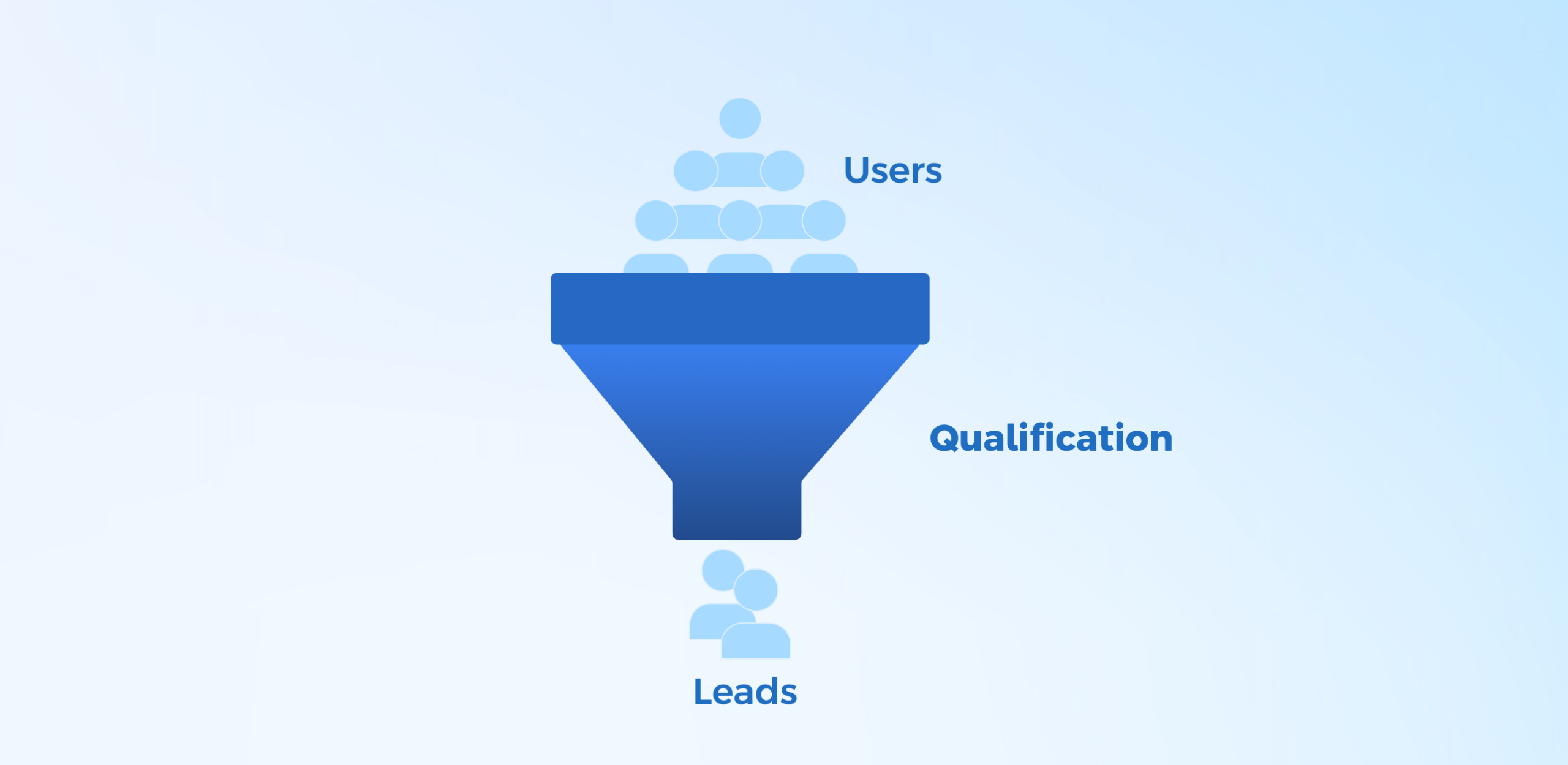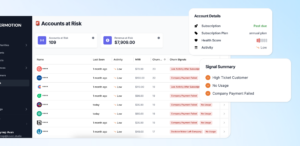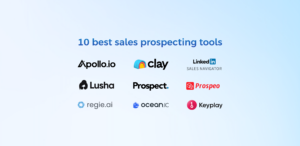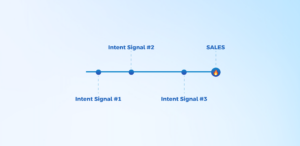Chasing every lead without understanding its value can be counterproductive. That’s why lead qualification, when performed, becomes powerful.
- Lead qualification is a strategy of predicting if a user is likely to become a customer or not, by using user data analytics and different product usage metrics.
- A lead qualification strategy helps businesses focus on the most promising leads. This saves time and resources.
- It starts by categorizing visitors as “users”. It scores them based on factors like demographics, activity, and buying intent. This categorization makes them “leads”.
- Expert insights suggest that lead qualification isn’t about excluding leads but prioritizing them for maximum ROI.
- Lead Qualification Frameworks like BANT, CHAMP, and MEDDIC offer different approaches to qualification.
What Is Lead Qualification?
Lead qualification is the process of evaluating and scoring leads based on their fit, interest, and readiness to buy your product or service.
A qualified lead can best be defined as a potential customer who exhibits certain characteristics that fit your business’s ideal customer profile. They are not random visitors. They have shown willingness and interest to interact with your business and possibly purchase your product or service.
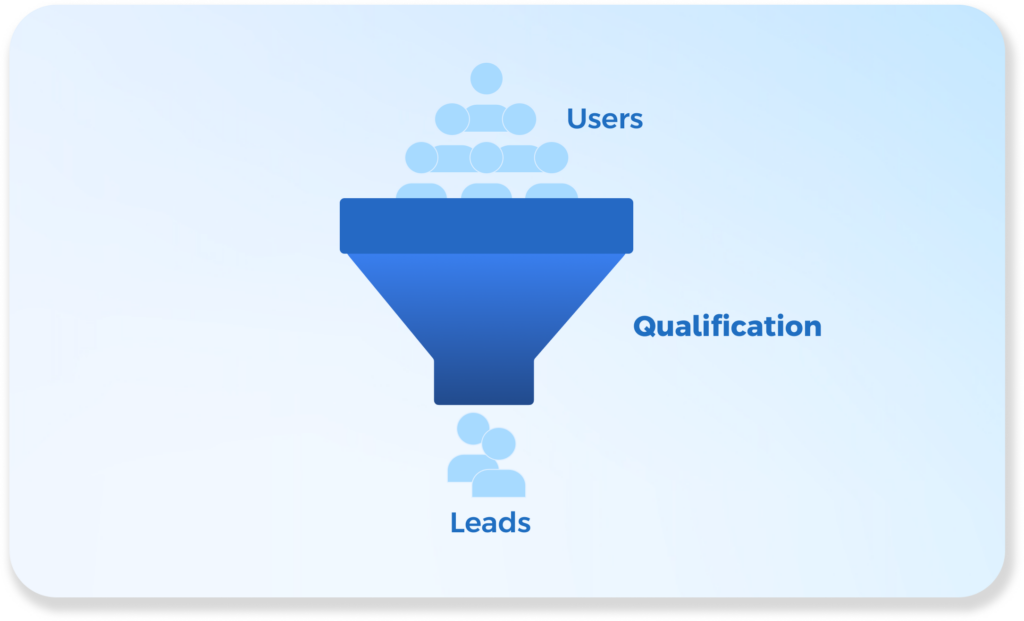
Lead qualification is more than a process. It’s a strategy for predicting if a user is likely to become a customer. It uses data analytics and different qualification metrics.
Most experts in the sector differentiate the lead qualification funnel. They start with “lead”, continue with “prospect”, and end with “sales.”” But today, I want to start with “user.” Why? Because a visitor can become a user and the “hot” lead qualification can start after that.
Why is Lead Qualification Important?
Qualifying your leads reduces the time and Customer Acquisition Cost (CAC).
Because someone visits your website doesn’t mean they’re the ideal lead for you. If they lack the qualities of your ideal customer, you’d better follow up with matching leads.
According to statistics, more than 90% of leads qualify but are not yet ready to buy. Thus, it is important to differentiate between lukewarm ones and hot prospects.
Lead qualification involves assessing factors such as;
- demographics
- company
- budget
But when you uncover its full power, it also involves factors such as;
- single user behaviors
- company behaviors
- total activity/when active
- needs, pain points, and challenges
- completion rate of key actions
Based on these, a lead qualification checklist ensures that the process is standardized across the team. Such a checklist often covers:
- Lead’s demographic information
- Budget, authority, need, and timeline (often referred to as the BANT criteria)
- Buying intent and interest level
- Engagement metrics
How to Use These Factors in Lead Qualification?
- Basic Scoring: The initial phase involves collecting basic data about a user, like name, company, budget, and job title. It lets you qualify your lead at the most basic level.
- High-level Scoring: Users can be high-level scored based on their engagement, behavior, and other data points related to their buying intent. Factors like email open, pain points, pricing page visits, times dashboard visited, user activity rate, company activity rate, and decision-maker signup contribute to a lead’s score.
- Categorizing: Based on the score, leads are categorized. Some common categories include Marketing Qualified Leads (MQLs), Sales Qualified Leads (SQLs), Product Qualified Leads (PQLs), and Product Qualified Accounts (PQAs).
- Personalized Engagement: Use the data now. Engage with high-scoring leads in personalized ways, and uncover if anything missing in the data.
- Feedback Loop: Sales and marketing teams should maintain an open line of communication. Feedback on the quality of leads helps in refining the qualification process.
According to Jenna Tanner, a renowned sales strategist, “The art of lead qualification isn’t about exclusion but prioritization.” It’s about identifying where to invest your energies for the maximum ROI.
How to Categorize Qualified Leads
Understanding the nuances of each type is fundamental to optimizing sales strategies. There are several types of leads:
Marketing Qualified Leads (MQLs)
At the heart of lead qualification are Marketing Qualified Leads (MQLs). These are potential customers who have shown a notable interest in your product or service but aren’t quite ready to make a purchase. They might have engaged with your marketing content by downloading e-books, signing up for webinars, or repeatedly visiting your website. What sets MQLs apart is their behavior indicating curiosity or consideration, not yet decision.
Identifying an MQLs: The Criteria
Identifying MQLs requires a keen understanding of customer behavior and a robust lead scoring system. Here are common ways to determine if a lead is an MQL:
- Behavioral Analysis: Monitoring how leads interact with your content, like page views, downloads, and social media engagement.
- Lead Scoring: Assigning numerical values to certain actions or demographic information to gauge interest and intent.
- Engagement Level: Assessing the depth of interaction, such as the frequency of visits or content consumed.
Examples of MQLs
Imagine a user who has visited your pricing page several times, downloaded a detailed product guide, and attended an industry-specific webinar. Their repeated engagement and specific interest in critical areas of your service make them a classic example of an MQL.
MQLs vs. SQLs: Understanding the Difference
While MQLs are potential customers who’ve shown interest, Sales Qualified Leads (SQLs) are a step further down the sales funnel. SQLs have been evaluated by the sales team and deemed ready for direct sales engagement. They are typically characterized by a more direct expression of interest in purchasing, such as requesting a demo or filling out a contact form. The primary differences lie in the degree of readiness and the nature of engagement, with SQLs requiring more immediate and direct sales attention.
Sales Qualified Leads (SQLs)
Sales Qualified Leads are the cream of the crop in lead qualification. These are prospects who have passed the initial stages of interest and engagement and have been deemed ready for the next step in the sales process. They are characterized by their fit with your target customer profile, their demonstrated interest in your product, and their potential readiness to make a purchasing decision.
Unique Characteristics of SQLs
SQLs stand out due to several distinctive features:
- Intent to Buy: Unlike casual browsers, SQLs have shown behaviors that indicate a strong intention to purchase, such as requesting a product demo or asking detailed questions about specifications.
- Fit Criteria: SQLs match the defined buyer persona of your ideal customer, aligning with specific criteria like company size, budget, industry, or other relevant factors.
- Engagement Level: These leads typically engage more deeply with your content or sales representatives, demonstrating a genuine interest and understanding of what you offer.
Identifying Sales Qualified Leads
Determining whether a lead is an SQL involves several techniques and criteria:
- Lead Scoring: This involves assigning numerical values to leads based on their actions and profile data. Higher scores indicate a higher likelihood of conversion.
- Lead Qualification Frameworks – like BANT: Evaluate leads based on their Budget, Authority, Need, and Timing to purchase.
- Lead Interaction: Analyze the lead’s interaction with your content and touchpoints. Frequent and meaningful engagements are good indicators of a qualified lead.
- Direct Communication: Pay attention to direct inquiries about product details, pricing, or implementation, as these are strong signals of a serious buyer.
Examples of SQLs
Here are a couple of examples to illustrate what an SQL might look like:
- A marketing director who has downloaded an ebook on industry trends, attended two webinars, and has now filled out a form requesting a consultation on your website.
- A small business owner who has frequently visited your pricing page, used your interactive tools, and has reached out via chat asking specific questions about product implementation.
Product Qualified Leads (PQLs)
Product Qualified Leads (PQLs) are potential customers who have used your product (often through a free version or trial) and taken actions that indicate a strong likelihood of becoming a paying customer. Unlike traditional leads, which may be based purely on demographic or firmographic data, PQLs show their interest through how they engage with your product.
What’s Unique About PQLs?
The uniqueness of PQLs lies in their qualification method. They are not just interested in your product; they have interacted with it enough to understand its value. This direct interaction provides a depth of insight that other qualification methods can’t match, making PQLs generally more informed and closer to a purchase decision.
Ways to Determine if a Lead is a PQL
- Usage Patterns: Look at how often and how deeply they use your product.
- Feature Adoption: Identify if they are using key features that indicate understanding and interest in your product.
- Progress in the Customer Journey: Check if they’ve completed significant milestones or actions in your product.
- Feedback and Requests: Pay attention to any direct feedback or feature requests they make.
Examples of PQLs
- A user who signs up for a free trial and uses your product multiple times in the first week.
- Someone who completes an onboarding process and starts using advanced features of your product.
- A free tier user who reaches out to customer support with questions about features available only in the paid version.
Product-Qualified Accounts (PQAs)
PQAs take the concept of PQLs but apply it at an organizational or account level.
They represent entire companies or teams that have shown a collective interest in a product, typically exhibited by multiple users from the same organization actively using a product and showing buying intent.
Let’s stick with the project management software. If a company has multiple employees sign up for trials, and several of them start exploring premium features or inquire about enterprise-level pricing, that entire company becomes a PQA.
PQAs are crucial because:
- They typically represent larger deal sizes, typically. Converting a PQA might mean multiple licenses or an enterprise-wide adoption.
- The buying process might involve multiple stakeholders and can be more complex. However, the ROI from converting a PQA can be significantly higher.
Companies tracking PQLs/PQAs saw free to paid conversion at 8%, compared to 6.5% for those companies not tracking.
HubSpot
Expansion Qualified Leads (EQLs)
An Expansion Qualified Lead (EQL) is a current customer who has been identified as having the potential for further business growth with your company through additional sales opportunities such as upselling or cross-selling. This type of lead already has a history with your product or service, providing a foundation of trust and experience that can be built upon to deepen the business relationship and increase revenue.
What’s Unique About EQLs?
EQLs are crucial. They are very important for the sustainable growth of any business today. EQLs tap into the existing trust and relationships with current customers. They offer a more reliable and cheaper way to grow revenue. This is compared to the uncertain and often costly process of acquiring new customers.
EQLs are nothing but an evolved form of Product Qualified Leads (PQLs). These leads arise from your existing customer base who already appreciate and utilize one of your product tiers. But here’s the twist! EQLs have a history of providing business to your company and present potential for further expansion.
What is the difference chart between an MQL, SQL, and PQL?
| Lead Type | Description | Example | Significance | Engagement Strategy |
|---|---|---|---|---|
| Marketing Qualified Leads (MQLs) | A person signs up for software updates | Downloads an eBook about software features | Fill out a “Request a Demo” form | Targeted marketing campaigns, webinars, and product literature |
| Sales Qualified Leads (SQLs) | Ready for the sales process | Individuals/entities who show vague interest | Highly interested potential buyers; ready for direct sales engagement | Personalized sales outreach, product demos, and tailored offers |
| Product Qualified Leads (PQLs) | Collective interest at the organizational level | A user of free CRM hits free tier limits | Users familiar with the product; high conversion potential | Direct outreach offering upgrade paths, and personalized demos showcasing premium features |
| Product-Qualified Accounts (PQAs) | Individuals/entities who show vague interest | Several employees from a company explore premium features | Signifies potential for bulk deals or enterprise-wide adoption | Account-based marketing, multi-stakeholder demos, and enterprise pricing discussions |
4 Lead Qualification Frameworks
Several lead qualification frameworks can guide you in assessing and scoring your leads. Some of the most popular ones include BANT (Budget, Authority, Need, Timeline), CHAMP (Challenges, Authority, Money, Prioritization), and MEDDPICC (Metrics, Economic buyer, Decision criteria, Decision process, Identify pain, Champion, Competition). These frameworks provide structured ways to evaluate a lead’s potential, helping you focus your efforts on the most promising prospects.
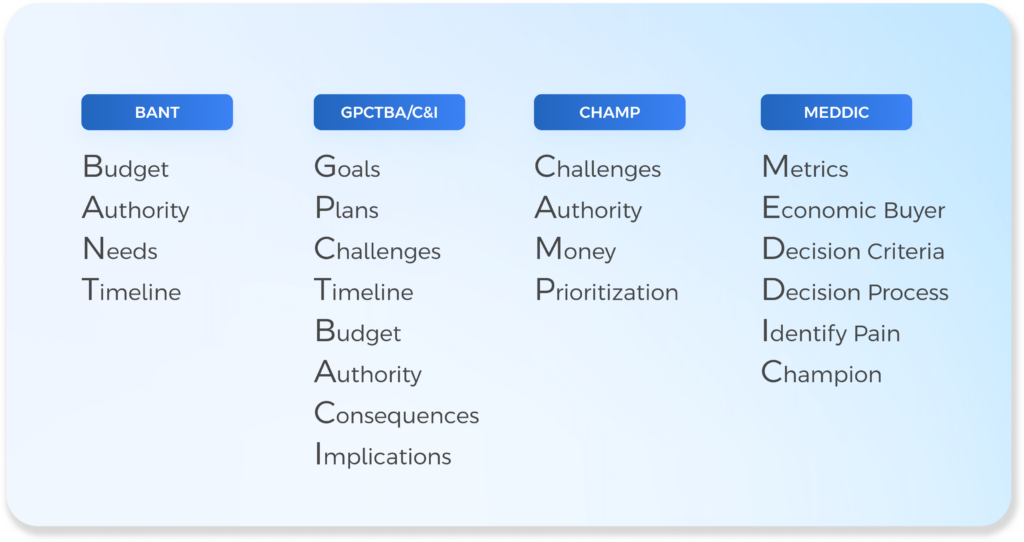
Sales and sales qualification process frameworks offer systematic methods to evaluate and categorize potential customers based on their suitability and the likelihood of conversion. The most favored models in sales qualification include BANT, GPCTBA/C&I, CHAMP, and MEDDIC
BANT
The BANT framework, pioneered by IBM, focuses on evaluating a prospect’s
- Budget: Examine the financial capacity of the potential lead for a purchase.
- Authority: Ascertain the decision-making prowess or sway a lead holds in their organization.
- Needs: Delve into the distinct requirements, obstacles, or issues the lead faces, which your offering might resolve.
- Timeline: Gauge the lead’s prospective purchase decision timeframe.
Thus, it helps marketing and sales teams determine if the prospect has the necessary resources, decision-making power, specific needs, and timeframe for making a purchase.
GPCTBA/C&I
HubSpot’s GPCTBA/C&I framework addresses changes in buyer behavior and aligns your company with the prospect’s goals and resources. Moreover, it involves exploring the prospect’s company itself;
- Goals: Identify what the lead is aiming for.
- Plans: Delve into their strategies to attain those objectives.
- Challenges: Unearth hindrances they’re grappling with.
- Timeline: Get a grip on their urgency to address issues.
- Budget: Probe their financial ability to afford a solution.
- Authority: Understand their decision-making influence.
- Consequences: Recognize potential downsides if they don’t overcome their challenges.
- Implications: Emphasize the benefits they’d accrue by tackling their problems.
CHAMP
In contrast to BANT, CHAMP centers around the prospect;
- Challenges: Pinpoint the issues the lead grapples with.
- Authority: Understand their decision-making capacity.
- Money: Gauge their financial capability.
- Prioritization: Determine their urgency and alignment with your sales process.
CHAMP, seen as an evolved version of BANT, stresses problem resolution over immediacy. It focuses on understanding the prospect’s pain points mainly.
MEDDIC
This framework points out the value that the product gives to a lead and includes;
- Metrics: Understand what KPIs matter to your lead.
- Economic Buyer: Engage with the primary decision-maker.
- Decision Criteria: Know what they’re looking for in a solution.
- Decision Process: Understand their internal buying journey.
- Identify Pain: Tailor your approach to solving their challenges.
- Champion: Build relationships within the lead’s company to facilitate the decision-making process.
MEDDIC framework works perfectly when you have a product-led approach.
The Lead Qualification Process: A Step-by-Step Guide and Checklist
By following these steps, businesses can streamline their sales process, focus on the most promising leads, and ultimately improve conversion rates and sales efficiency. Remember to customize the steps as needed to fit the specific context and needs of your business or industry.
- Understanding Your Ideal Customer: Begin with a clear visualization of your perfect customer. This is the foundation of any lead qualification strategy.
- Lead Qualification Criteria: Establish benchmarks that a lead needs to achieve to be considered worthwhile. This might include their budget, company size, or specific challenges that your product can solve.
- Data Gathering: Use online tools, website analytics, and other methods to gather as much information about your leads.
- Lead Scoring Mechanisms: Assign scores to leads based on their activities. For instance, downloading a product brochure might carry a certain score, while signing up for a demo might carry a higher score. According to a study by Marketo, companies that excel at lead scoring experience a 77% increase in lead generation ROI, compared to their peers.
- Engagement & Nurturing: Just because a lead isn’t ready to buy now doesn’t mean they won’t in the future. Engage them with personalized content, offers, and insights to keep your brand top of their mind.
Here’s how the checklist for lead qualification can be used for the further lead qualifying process.
| Step Number | Qualification Criteria | Description |
|---|---|---|
| 1 | Identify Customer Needs | Determine if the lead has a need that your product or service can address. |
| 2 | Budget Check | Ascertain if the lead has an appropriate budget for your product or service. |
| 3 | Authority | Verify that the lead has the authority to make purchasing decisions. |
| 4 | Timeline | Understand the lead’s timeline to purchase and whether it aligns with your sales cycle. |
| 5 | Fit | Assess whether the lead’s company size, industry, and other factors make them a good fit. |
| 6 | Engagement Level | Evaluate the lead’s interest based on their engagement with your brand. |
| 7 | Previous Solutions | Understand what solutions the lead has tried before and why they are looking for a new one. |
| 8 | Decision Criteria | Determine the criteria the lead will use to make the purchasing decision. |
| 9 | Pain Points | Identify the lead’s key challenges and how your solution can solve them. |
| 10 | Competitive Position | Know your competition and understand if the lead is considering other options. |
| 11 | Compliance and Requirements | Ensure any specific requirements or regulations the lead needs to comply with can be met. |
| 12 | Confirmation to Proceed | Confirm that the lead is interested and willing to take the next steps. |
You can use this table in your article to clearly outline each step of the lead qualification process. It provides a structured overview that readers can easily understand and follow. Each step is a critical component in assessing whether a lead is worth pursuing, and the table format makes the information accessible and actionable.
Final Words
The key to sales success lies in the art of effective qualification. Your ability to identify prospects who are a good fit for your business can significantly impact your overall success.
Converting these prospects into satisfied customers not only generates revenue but also opens doors to potential word-of-mouth marketing, referrals, and opportunities for cross- or upselling. Thus, it is absolutely crucial to master the skill of qualification and ensure you make the right choices from the start.

